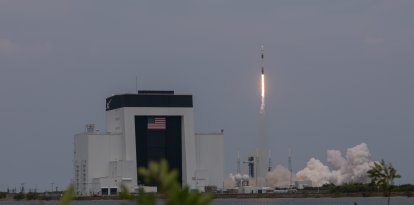M1 Abrams tank, the "King of the Battlefield"
First introduced during the Gulf War, the tank has been upgraded to remain essential to U.S. military efforts today.
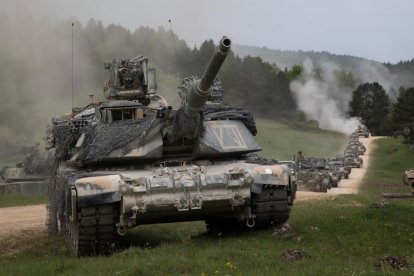
(M1 Abrams)
"Wave upon wave of tanks and infantry would come (...) only to be destroyed," recalls one U.S. soldier from the M1 Abrams debut. It came during Operation Desert Storm in the 1990s to drive Iraqi forces out of Kuwait. Another soldier recalls:
The Abrams' prospects were not good. After a decade gathering dust, the tanks would first enter combat on inauspicious terrain. Designed to fight against Soviet forces in Europe, they had to move through the uneven desert amidst dust storms that threatened to slow and damage them.
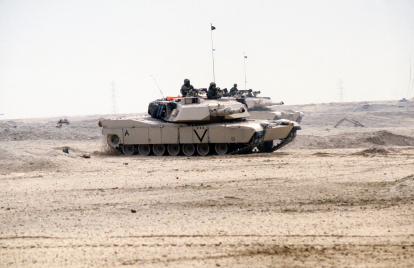
M1A1 Abram battle tanks during Operation Desert Storm.
M1A1 Abram battle tanks during Operation Desert Storm. (Digital Public Library of America)
But, as Steve Zaloga's "M1 Abrams: Main Battle Tank" explains, the new vehicle's technological advances, in addition to the readiness of its crew, allowed for an overwhelming victory. Thermal vision, for example, allowed them to see through the dust and smoke, attacking blind enemies: "It was not a fair war, we did not even know you were in the area when our tanks started blowing up," an enemy prisoner would later say. Its armor resisted the onslaught of the Iraqis' Soviet T-72, and its ammunition responded by penetrating the enemy tank "like a hot knife through butter."
The operation resulted in 3,487 Iraqi tanks destroyed or captured, and no Abrams succumbed to enemy fire. Its sweeping victory in "the largest armored battle in history," in the words of veteran Michael Black, crowned the M1 Abrams as the "King of the Battlefield."
Royal armor
In 1972, the United States decided to build a tank capable of combat against the Soviet Union and its Eastern allies. Specifically, its goal was to prevent the advance of communist forces across the "north German plains," explains defense specialist David Baker. "The M1A1 Abrams was the answer."
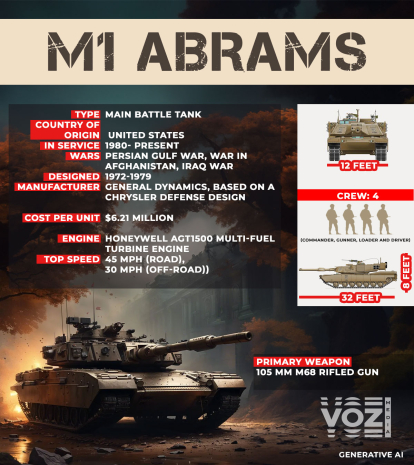
m1-ing
(Christian Camacho / Voz Media)
The Abrams has undergone numerous modifications since its first deployment in the Middle East, where it had to be transported by sea because the larger aircraft, the C-5 Galaxy, would have had to be loaded one at a time. Its weight depends on the exact model. It comes in between 110,000 and 160,00 pounds when fully equipped for combat.
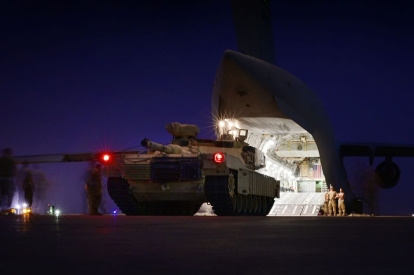
Airmen load an M1A2 Abrams tank onto a C-17A Globemaster III aircraft in Kuwait in 2022. / (DOD)
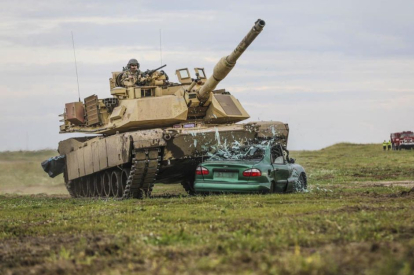
An M1 Abrams tank crushes a car during a drill in Poland, 2019.
An M1 Abrams tank crushes a car during a drill in Poland, 2019. / (DOD)
The 1,500-horsepower turbine engine, which allows it to reach speeds of 40 mph on-road and 30 mph off-road, the 120 mm main gun and its "special armor" make it "particularly lethal against heavy armor forces," per the U.S. Army Acquisition Support Center.
As part of its frame, it has an explosive charge, mounted between two metal plates. As explained by Real Engineering, this device is particularly effective against "hollow charges," anti-armor projectiles that explode upon impact with the vehicle. Despite its size, it also has technology to "camouflage" itself from the enemy: it creates a smokescreen by spraying fuel into its exhaust or by launching grenades that, when exploding, decrease visibility.
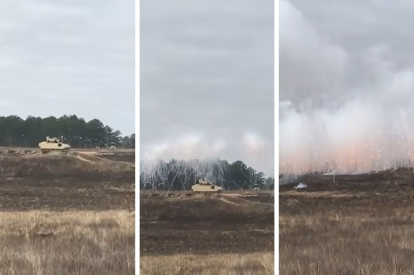
The M1 Abrams can be camouflaged by throwing six to twelve grenades at 30 meters from the tank (YouTube: Real Engineering).
The crew of four (commander, gunner, loader and driver) has chemical, biological and nuclear anti-armament protection. Real Engineering explains that the human loader distinguishes the M1 Abrams from other tanks, which tend to automate fueling:
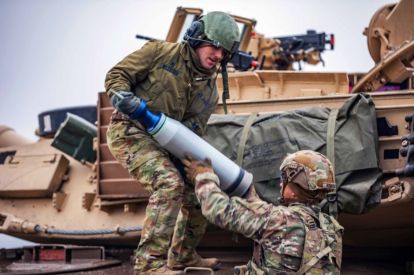
Abrams M!
Soldiers load ammunition into an M1A2 Abrams tank during an exercise in Poland, 2023. / (DOD)
A tank... for what?
Tanks are owned almost exclusively by the Army. In 2020, the Marines announced a transfer of their more than 400 armored vehicles to the Army. "Army is huge," said Commanding General David H. Berger in defense of his decision in remarks picked up by Marine Corps Times:
Logistics was one of the driving factors behind the move. Tanks are difficult to transport and expensive to acquire and maintain. In the words of Lt. Gen. Eric Smith: "You simply can't be there in time."
"You don't need tanks unless you want to win," argued General James McConville during an official visit to Australia this year. The then Army chief of staff (he left his post in early August) defended the usefulness of armored vehicles, including tanks, two weeks after Australia announced it would reduce its stock of such vehicles.
McConville maintained, in statements to the Australian media, that these battle tanks were necessary to carry out offensive ground operations. Success, he explained, lies in synergy:
In this regard, it is worth noting that the Armed Forces inventory is not limited to the M1 Abrams. It also has wheeled vehicles such as the Stryker to transport infantry, or self-propelled artillery such as the M109 Paladin, which wields a 155-millimeter howitzer.
To Ukraine
Earlier this year, President Biden announced that the M1 Abrams would finally fight in the Eastern European territory it was originally designed for. The United States began sending them to Europe to assist Ukraine. Germany also agreed, pledging to send about 15 of its Leopard 2s.
The first batch of U.S. tanks is set to arrive in the hands of Ukrainian forces in September, Politico reported.
The Abrams of the future
In keeping with the process of constant improvements to the Army's main battle tank, the Abrams' next iteration is called M1A2 SEPv4.
"The most lethal Abrams tank is now in development," explains the U.S. Army Acquisition Support Center. "This program began early enough to onboard any technology the Army deems critical to the future battlefield to include artificial intelligence, autonomy, APS [Active Protection System], or advanced sensors."
Among other improvements, it will utilize technology to improve visibility, including a laser pointer and color camera. It will also have more precision and firepower. "Will the Abrams SEPv4 tank become the unstoppable [main battle tank] of the U.S.?" wondered Christian Baghai, a statistical programmer and regular writer on warfare technology, in a recent post. "Only time will tell."
RECOMMENDATION



